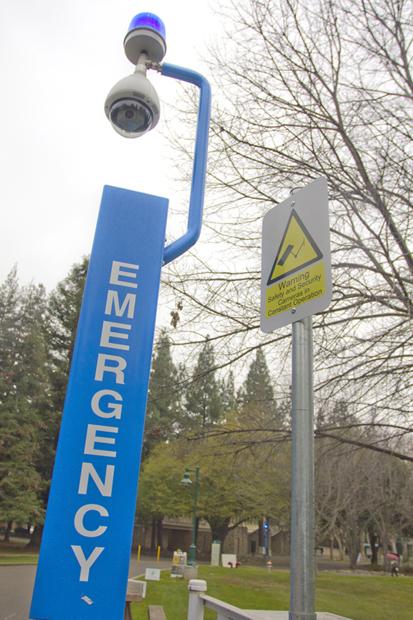Blue emergency phones just one piece of the puzzle
One of more than 150 Blue Phone emergency telephones, this one near the Library Quad acts as a direct line to Sac State police.
January 29, 2013
Short of placing armed guards around campus, Sacramento State has been able to implement a network of systems that help to limit crime and increase the safety of students and faculty.
The systems include a combination of text and e-mail alerts; cameras; speakers; extra community service officers; and the giant blue phone towers, which are the most noticeable of all.
There are more than 150 blue-light emergency phones placed on and around the Sac State campus.
The purpose of the blue phones is to provide easy access to the Sac State police department’s direct line.
Once a possible victim or witness activates the phone, they will be connected with the department’s dispatch center. The blue phone will also provide a voice recording as events unfold.
“The blue phones were installed several years ago and there are plans to augment the current number of phones to increase coverage,” said police chief Mark Iwasa. “The blue phones are a system put into place primarily for someone who feels that an unsafe situation is descending upon them.”
Iwasa said the police department has the capability to respond to any blue phone call within two minutes.
Depending on where an incident takes place, video recording are sometimes available to assist in identifying perpetrators or victims. Iwasa said the number of cameras located around campus is more than 500.
The camera system is a part of the revamped Sac State campus security policy. In accordance with the policy, the Cisco Safety and Security External Camera System covers the stadium, parking lots and any area where a high volume of students may gather.
To accompany the camera system, Sac State has also installed a Visiplex audible alert system.
“The (Visiplex) speakers are strategically placed,” Iwasa said. “The speakers are placed so that virtually every part of the main campus (is covered) and will (receive) an audio message.”
All of the safety and security tools are a part of the Emergency Notification System (ENS).
The ENS is most closely associated with the text and e-mail alert system that has been a part of Sac State for some time. However, the system in place now is a new, more effective program in terms of working as intended based on administered test runs.
Prior to 2012, the system was marred by failure due to system overloads. Basically, the system could not handle the high volume of data being distributed, which resulted in emergency messages being sent out hours after the situation was controlled.
“The current ENS system has one downfall,” Iwasa said. “(Students and faculty) have to register for it to work. Our compliance rate (for registration) is around 30 percent.”
Plans are in the works to require students to register for ENS during enrollment into Sac State.
It is unclear how well the combination of blue phones, cameras, CSOs and speakers will work when it comes to saving lives, because the true test has yet to come.

































































































































